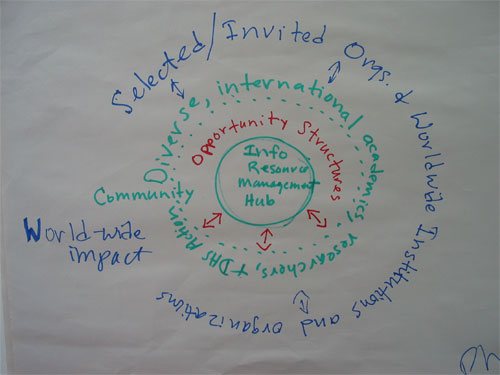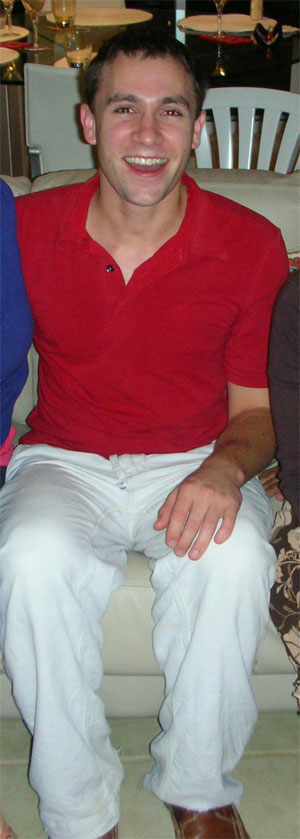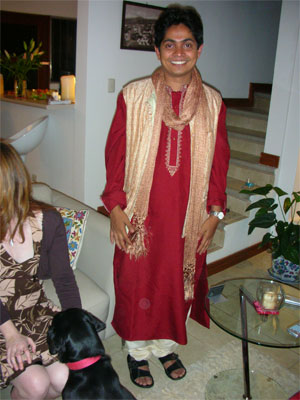7th Annual Conference of Human Dignity and Humiliation Studies
at the United Nations-mandated University for Peace,
San José, Costa Rica,
6th-9th September, 2006
Victoria C. Fontan very kindly organised our meeting!
She is the
Director of Academic Development, and Assistant Professor of Peace and Conflict Studies at the United Nations-mandated University for Peace in San Jose.
A big thank-you to you, dear Victoria!
And another big thank-you to UPeace for your great hospitality!
(Please see here an interview with the Rector of UPeace, Julia Marton-Lefèvre, where also UPeace's global work is very well explained)
Local Host, Organizer, and Convener

Victoria Fontan
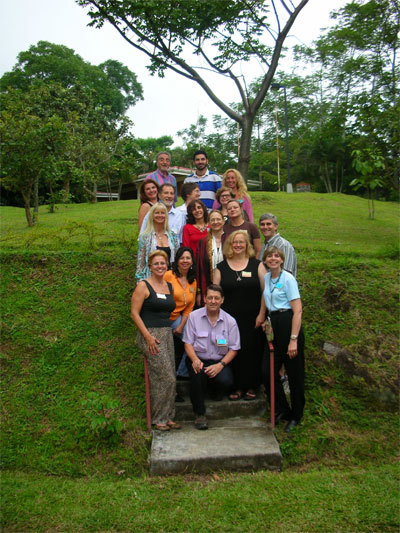
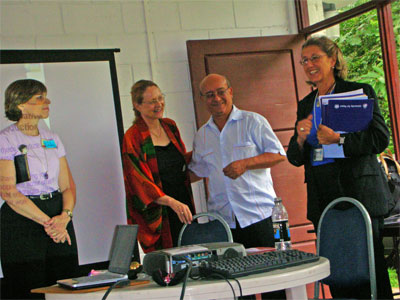
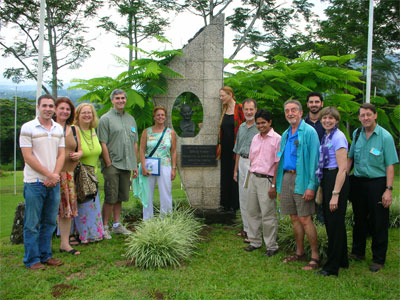




Please click on the pictures to see them larger
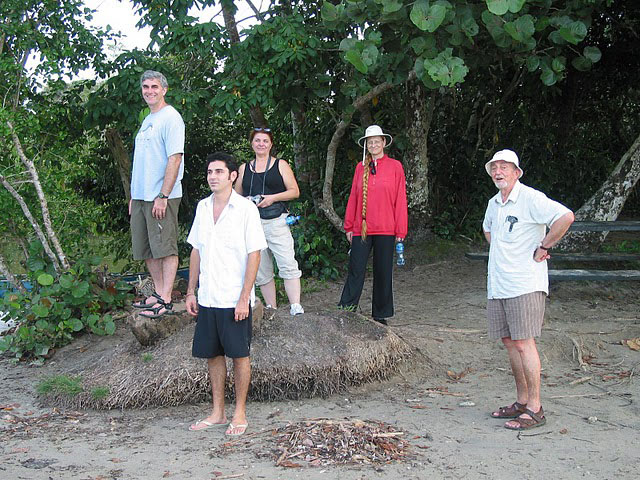
Please see the beautiful pictures by Phil Brown: Costa Rica I and Costa Rica II
(Important note to our conference particants: During our conference, we asked for your permission to be posted here, however, if you have changed your mind since, either in total or for specific pictures/videos, please let us know! Thank you! Since we wish to walk the talk of dignity, it is very important for us to do our utmost in respecting everybody's privacy. We refrain from gathering written permissions from you during our conferences, since we value the building of mutual trust in relationships, and we also would like to refrain from contributing to an ever more bureaucratic and legalistic society.)
Our meeting has three parts:
• Public Conference
Saturday, 9th September 2006, 9.00-12.00, UPeace Council Room
• Post-Conference Trip
After our public conference, some of us went for a post-conference trip to the Carribean, about 3.30 hours from the UPeace location. We originally planned to stop on the way for a walk through the cloud forest or a visit to the Earth University, however, we have to leave that to the next time.• Workshop Part
6th-8th September, 2006, UPeace Student Lounge• Housing
Christopher Santee most ingeniously kept us all alive and well housed! See for a choice of very good and not too costly hotels: Hotel Canal Grande (very beautiful and not at all costly), Corteza Amarilla Lodge (lavishly creative and beautiful, a bit more costly).
• Please kindly note that...
• There is no registration fee for our conferences. To cover our expenses, we always summarise the costs during the conference and invite participants to contribute according to their ability. This collaborative approach to financing allows us to keep the conference affordable for all.
• We like to get to know participants prior to our conferences and workshops, and prior to issuing an invitation.
• All our gatherings are by invitation only, please approach us so that we can include you and register you. Only our Public Events are open to everybody without registration.
• The Non-Public Parts of our gatherings have limited enrollment.
• Participants are encouraged to find their own sources of funding or economic support to participate in our conferences. We offer our nurturing work as our gift of love and care to you, and we would like to lovingly invite everybody to contribute to this gift economy. If you need funding for your travels and housing, please inquire in your country and your university about possibilities. See, among others, for the US, www.supportcenter.org and www.foundationscenter.org. The Weinstein International Fellowship program, inaugurated in 2008, provides opportunities for individuals from outside the United States to visit the U.S. to learn more about dispute resolution processes and practices and to pursue a project of their own design that serves to advance the resolution of disputes in their home countries.
• Participants in our conferences are kindly asked to handle all of their travel arrangements and required documentation, including requests for visas, on their side. HumanDHS is a volunteer initiative and does not have the staff or resources to assist with visa requests.
• Permissions
During our conferences, we always ask all participants for their permission to have their pictures or videos posted on our website, however, if you change your mind later, either in total or for specific pictures/videos, please let us know! Thank you! Since we wish to walk the talk of dignity, it is very important for us to do our utmost in respecting everybody's privacy. We refrain from gathering written permissions from you during our conferences, since we value the building of mutual trust in relationships, and we also would like to refrain from contributing to an ever more bureaucratic and legalistic society.
• What happened in our previous meetings?
Please have a look at our previous meetings and at the newsletters written after these meetings!
• We had a preparatory online discussion prior to this meeting
• See our newsletter Nr. 7, compiled subsequent to this meeting
Overview
Frame
• Frame
• List of Conveners
Programme
• Programme of the Public Conference
• Programme of the Workshop Part of the Meeting
• Open Space
Participants
• List of Participants
Before and After
• Preparatory online discussion prior to this meeting
• See our newsletter Nr. 7, compiled subsequent to this meeting
Pictures
• Pictures, Day One, Evelin's camera
• Pictures, Day Two, Evelin's camera
• Pictures, Day Three, Evelin's camera
• Pictures, Day Four, Public Event, Victoria's talk, Evelin's camera
• Pictures, Day Four, Public Event, Julia Marton-Lefèvre, and Victor Valle, Evelin's camera
• Pictures, Day Four, Public Event, Evelin's talk, Evelin's camera
• Pictures, Day Four, Five, and Six, Excursion to Cahuita, Evelin's camera
• Pictures, Day Seven, Excursion to Volcano Poas, and Sarchi, Evelin's camera
• Pictures, Farewell for Evelin, 20th September, Evelin's camera
• Pictures, Linda's camera
• Pictures, Day Three, Statues in the Upeace Park, Linda's camera
University for Peace
The University is established with a clear detarmination to provice humanity with an international institution of higher education for peace and with the aim of promoting among all human beings the spirit of understanding, tolerance and peaceful coexistence, to stimulate cooperation among peoples and to help lessen obstacles and threats to world peace and progress, and keeping with the noble aspirations proclaimed in the Charter of the United Nations.
University for Peace Charter
United Nations General Assembly Resolution 35/55
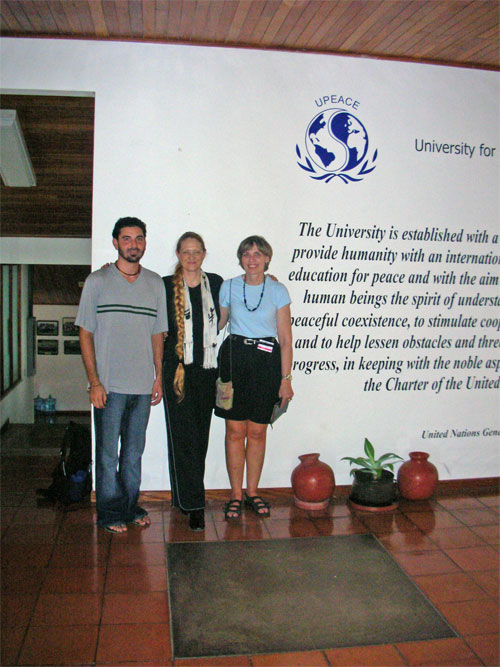
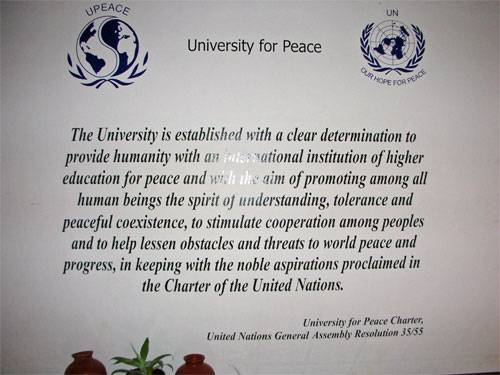

These pictures were taken on 4th August, 2006, with Christopher Santee, Linda Hartling, and Evelin Lindner in front of the University for Peace Charter. Please click on the pictures to see them larger.
Frame
by Linda Hartling, 2004, Ph.D., Associate Director, Jean Baker Miller Training Institute, Wellesley College, Boston, USA
We are pioneering a
model of engagement that facilitates the growth of all people. We are
trying to move beyond conventional practices that can subtly undermine
human dignity by devaluing the experience of disadvantaged individuals in
favor of advantaged individuals. At the same time, we want to benefit
from the knowledge "experts" have to share.
In our meetings we aim at creating a humiliation-free, collaborative learning environment characterized by mutual respect, mutual empathy, and openness to difference. The perspective of "appreciative enquiry" is a useful frame of our work. Our HumanDHS efforts are not just about the work we do together, but also about HOW WE WORK TOGETHER. At appropriate points during our meetings, for example at the end of each day, we take a moment to reflect on the practices observed that contributed to an appreciative/humiliation-free learning experience.
It is important to emphasize that an appreciative approach is not about expecting people to agree. In fact, differences of opinion enrich the conversation and deepen people's understanding of ideas. Perhaps, this could be conceptualized as "waging good conflict," which means practicing radical respect for differences and being open to a variety of perspectives and engaging others without contempt or rankism. As we have seen in many fields, contempt and rankism drains energy away from the important work that needs to be done. Most people only know "conflict" as a form of war within a win/lose frame. "Waging good conflict," on the other side, is about being empathic and respectful, making room for authenticity, creating clarity, and growth.
Please read An Appreciative Frame: Beginning a Dialogue on Human Dignity and Humiliation, that Linda has written for us in 2005.
Please see also Appreciative Facilitation: Hints for Round Table Moderators, kindly written in February 2006 by Judith Thompson to support the moderators of our workshops.
Please see furthermore Buddhist Teachings on Right Speech, kindly provided to us by Thomas Daffern in 2006, relating to our quest for appreciative enquiry, caring and being.
List of Conveners
Evelin Gerda Lindner, Medical Doctor, Clinical and Social Psychologist, Ph.D. (Dr. med.), Ph.D. (Dr. psychol.), Organiser of the HumanDHS Conferences, Supporting the Local Conveners
Evelin G. Lindner is the Founding Director and President of Human Dignity and Humiliation Studies (HumanDHS). She is a transdisciplinary social scientist, affiliated with the Columbia University Conflict Resolution Network, New York, the University of Oslo, Norway, Department of Psychology (folk.uio.no/evelinl/), and the Maison des Sciences de l'Homme, Paris. Lindner is also an Associate Professor at the Norwegian University of Science and Technology (NTNU) in Trondheim, Department of Psychology, Norway, and teaches globally, including in South East Asia, the Middle East, Australia, Africa, and other places globally. [read more]
Linda Hartling, Ph.D., Social Psychologist, Organiser of the HumanDHS Conferences, Supporting the Local Conveners
Associate Director, Jean Baker Miller Training Institute, Wellesley College, Boston, USA. Linda Hartling is a Member of the HumanDHS Board of Directors, a Member of the HumanDHS Global Advisory Board, Global Core Team, and Education Team.
Please see:
• Humiliation: Real Pain, A Pathway to Violence, the draft of Linda's paper for Round Table 2 of our 2005 Workshop on Humiliation and Violent Conflict, Columbia University, New York.
• Humiliation: Assessing the Impact of Derision, Degradation, and Debasement, first published in The Journal of Primary Prevention, 19(4): 259-278, co-authored with T. Luchetta, 1999.
• Shame and Humiliation: From Isolation to Relational Transformation, the Jean Baker Miller Training Institute (JBMIT), Wellesley Centers for Women, Wellesley College No. 88, Wellesley, MA 02481, co-authored with Wendy Rosen, Maureen Walker, Judith V. Jordan, 2000.
• Humiliation and Assistance: Telling the Truth About Power, Telling a New Story, paper prepared for the 5th Annual Conference of Human Dignity and Humiliation Studies 'Beyond Humiliation: Encouraging Human Dignity in the Lives and Work of All People', in Berlin, 15th -17th September, 2005.
Victoria C. Fontan, Ph.D.
Victoria C. Fontan is Director of Academic Development and Assistant Professor of Peace and Conflict Studies at the United Nations-mandated University for Peace in San Jose, Costa Rica. As a Fellow to the Iraq Project at the CICR in Columbia University, Victoria is in charge of developing a permanent Conflict Resolution curriculum in northern Iraqi universities.
Victoria Fontan is a Member of the HumanDHS Board of Directors, and a Member of the HumanDHS Global Core Team, and the Research Team.
Christopher Santee
Christopher Santee is currently studying and residing in San José, Costa Rica. He obtained a Bachelor's degree in Interdisciplinary Studies with a focus on Peace Studies from Naropa University in Boulder, Colorado, USA in 2005. Christopher has been working and interning at the United Nations-mandated University for Peace in Costa Rica since February, 2005. He hopes to enroll in a masters degree program in a yet-to-be determined institution for Sustainable Development, Peace Studies or International Relations with a focus on Latin America.
Christopher is also a Member in our HumanDHS Education Team, and Project Associate of the Journal of Human Dignity and Humiliation Studies (JHDHS). [read more]
Programme for the Public Conference
Saturday, 9th September 2006, 9.00-12.00, UPeace Council Room
Please see here the pictures from Linda's camera
• Linda Hartling, and Christopher Santee Welcomed Everybody to Our Public Conference
• Presentation: Back to the Thinktank: Humiliation Awareness as a Nonviolent Form of Counter Terrorism
Victoria C. Fontan, Director of Academic Development, and Assistant Professor of Peace and Conflict Studies at the United Nations-mandated University for Peace in San Jose
Victoria holds a Ph.D. in Peace and Development Studies. She published various papers on multi-track diplomacy, human trafficking, the public diplomacy of armed groups and the formation of political violence in post-conflict societies. Central to her work has been a conceptualisation of post-conflict processes through the study of social, gendered, cultural, economic and political humiliation. She conducted field research in Lebanon with the Hezbollah, in Bosnia-Herzegovina on human trafficking and organised crime, and in Fallujah (post-Saddam Iraq) with emerging armed groups. She is also involved in gender training for peacekeeping operations, and has lectured to various armed forces on the subject. Please read more here.

Please click on the picture to see all the photos of Victoria's talk from Evelin's camera

Please click on this picture to see it larger. Linda took this picture!
• The Rector of the University for Peace, Julia Marton-Lefèvre, and Dean Victor Valle, Welcomed Everybody to the University for Peace


Please click on the pictures to see more photos from Evelin's camera
• Presentation: Humiliation in a Globalising World
Evelin Lindner, Founding Director and President of HumanDHS
Please see background material:
Humiliation in a Globalising World: Does Humiliation Become the Most Disruptive Force?
and
Recognition or Humiliation - The Psychology of Intercultural Communication
Please click on the picture to see all the photos of Evelin's talk from Evelin's camera
• Discussion
• Reception
• Post-Conference Activities
After our public conference, some of us went for a post-conference trip to the Caribbean, to Cahuita, about 3.30 hours from the UPeace location, where we stayed for two nights (10-11th September). The following day, some of us went to the Poas volcano, and to Sarchi (12th September).
Cahuita National Park:
Early records from the Cahuita area show that it was one of the favorite sites used by Miskito Indians (from Nicaragua) for turtle hunting. These Indians called this place Cahuita which means “point where the Sangrillo tree (Pterocarpus officianalis) grows” due to the abundance of this tree species.
In 1970, the government of Costa Rica declared Cahuita Point’s Coral Reef a National Monument. In 1978, 1,068 hectares of coastal land and a marine area of 22,400 ha surrounding Cahuita Point were declared a National Park. Cahuita National Park was the first marine park in Costa Rica.
On the April 22, 1991 a powerful earthquake lifted the surrounding land and seafloor approximately one meter and considerably affected the ecosystem of one of the most diverse and beautiful coral reefs of the Costa Rican coast.
Today, Cahuita’s reef is composed by nearly 35 species of coral; it hosts 140 species of mollusks, 123 species of fish and 128 species of algae. The reef covers an area of 600 hectares.
The success of Cahuita National Park is based on a pioneering effort to involve the local community in its management. Through their participation in the Cahuita Co-Management Committee, the local community takes part in the vigilance and maintenance of the park’s natural resources, promoting conservation and sustainable tourism. (See alo http://www.nacion.com/netinc/costarica/parques/cahuita.html.)
Please click on the picture to see all the photos of Don, Alan, Marta, Phil, Christopher, and Evelin, from Evelin's camera

We stayed at the paradise of Kelly Creek with Marie-Claude and Andreas (Hotel - Restaurant, Cahuita, Playa Blance, Entrada Al Parqe Nacional, Costa Rica, Tel. 7550007, kellycr@racsa.co.cr, www.hotelkellycreek.com). Please click on the picture to see it larger.

Please click on the pictures to see more portraits of Marta and Christopher from Evelin's camera
On 12th September, some of us went to the Poas volcano, and to Sarchi.
Volcan Poas National Park
Volcan Poas is one of the most visited volcanoes in Costa Rica, because of its proximity to San Jose and because of the luxuriant forest that surrounds the two craters. The park measures 5600 hectares, and this basaltic volcano stands at an altitude of 2708 meters (8,200 feet) above sea level.


Please click on the picture to see all the photos of Don, Alan, Marta, and Evelin, from Evelin's cameraThe Oxcart Factory in Sarchi
The oxcart, painted in bright colours and unique geometric designs, has become a symbol of Costa Rica. The tradition of craftsmanship goes back to the early 20th century when an ingenious farmer decided to break the norm and assert his individuality by painting his oxcarts with a design. The trend caught on throughout Costa Rica and today Sarchi is a famous artisan centre. Visitors can tour the oxcart factory or just shop to their hearts content in several souvenir shops, which display all types of handicrafts.

Please click on the pictures to see them larger
Programme for the Closed Part of the Meeting
6th-8th September, UPeace Student Lounge
Please see here the pictures from Linda's camera
Day One, 6th September
Please see here the pictures of Day One from Evelin's camera
9.00 Registration
9.15 Participants presented each other (by first interviewing another participant and then speaking as if s/he was him or her)
The Rector of the University for Peace, Julia Marton-Lefèvre, and Dean Victor Valle, welcomed everybody to the University for Peace

Please click on the picture to see all the photos of Day One from Evelin's camera
10.30 Welcoming All Participants
Donald Klein and Linda Hartling welcomed everyody and set the frame of our meeting within "Appreciative Inquiry." Please read An Appreciative Frame: Beginning a Dialogue on Human Dignity and Humiliation, that Linda has written for us in 2005.
Linda usually keeps our workshop together with her continuous caring interventions, and Don's caring wisdom always carries our meetings through crucial moments! Thanks you to you both!
Ragnhild Nilsen Welcomed Everybody With a Song
11.00-12.30 Introductory Presentation: Humiliation in a Globalising World: Does Humiliation Become the Most Disruptive Force?
Evelin Lindner, Founder of HumanDHS
This talk highlights how globalisation is interlinked with new and unprecedented psychological dynamics that call for novel solutions at all levels - macro, meso and micro levels, and in all fields of public policy.
Please see the full paper here or at http://ssrn.com/abstract=668742 (this paper's SSRN ID is 668742)
12.30-13.30 Lunch
13.30-16.00 Open Space
Our Open Space was kindly facilitated by Alan Klein. The Open Space began on Day One, and continued on Day Two and Day Three. The program for the Open Space on Day Two and Three emerged during Day One. Please read here more about the Open Space and what it entails.

This is Alan, please click on the picture to see it larger
These were the topics that were proposed:
Wednesday:
• Religious Fundamentalism, Dignity, and Discussion (convener: Pandora Hopkins, please see here Pandora's Summary)
• Dignity and Humiliation While Managing NGOs (convener: Marta Carlson)
• Humour and Humiliation - Or, When Humiliation Is Amusing (convener: Myra Mendible)
Thursday:
• Shame and Humiliation (convener: Amy Hudnall)
• Dignity and Friendship in Politics (convener: Sibyl Ann Schwarzenbach)
• Ethical Commerce - What Can We Do to Contribute? (conveners: Ragnhild Nilsen & Anne Katrine Hagelund)
• HumanDHS'sEducation Programme Development / Dignity Education (conveners: Don Klein, Stephanie Heuer, please read here Ideas for Integrating Dignity into Education by Nick Martin)
Friday:
• How to "Organize" the Network to Serve its Purpose (convener: Philip Brown. Please see more details further down under Future Work on Day Three)
16.00 End of Day One
Day Two, 7th September
Please see here the pictures of Day Two from Evelin's camera
Please see here the pictures from Linda's camera
9:00 Welcome
9.30 - 10.15 The Humiliation Dynamic: Looking Back... Looking Forward
Donald Klein, Union Institute and University, Cincinnati, Ohio, USA. Donald Klein is a Member of the HumanDHS Board of Directors, a Member of the HumanDHS Global Advisory Board and Global Core Team. He is furthermore the Director of our Education Team.
10.30-13.00 Open Space Continued from Day One
13.00-14.00 Lunch
14.00-15.00 icohere Internet Demonstration and Conversation with Pascal Kaplan
Pascal Kaplan first gave us an introduction, then he toured the site, and finally, he used the last minutes for questions and dialogue with the group.
Philip Brown introduced icohere to our group on June 1, 2006, by email: "I have gotten to know the founder and co-president of this group which offers cutting edge internet based collaborative resource tools and is a values-driven organization which uses appreciative inquiry as a primary consultation strategy. They have also worked internationally, and we could do a live demonstration of how they have worked."
15.00 End of Day Two

Please click on the picture above to see it larger

Please click on this picture to see all the photos of Day Two from Evelin's camera
Day Three, 8th September
Please see here the pictures of Day Three from Evelin's camera
Please see here the pictures from Linda's camera
Please see here the pictures of the statues in the Upeace Park, from Linda's camera
9:00 Welcome
9.30-10.15 General Discussion
10.30 Excursion
We all went to say hello to the Rector of the University for Peace, Julia Marton-Lefèvre, and then we took a walk through the campus and the park, visiting all the statues in the park (Gandhi, Tolstoi, Eleonor Roosevelt, Albert Schweitzer, and so on).

This is part of our group in front of Gandhi's statue. Please click on the picture to see all the photos of Day Three from Evelin's camera



Please click
on this picture to see all the other statues in the UPeace park! Linda took these pictures!
12.00 Future of our Work
Everybody shared with the group how he or she would envisage our work in 10 years, if it served his or her needs optimally. The question was: "How should the network look like in 10 years to serve your needs?"



Please click on the pictures to see them largerEvelin:
1. "Revolutionary optimism": I would wish that in ten years the notion of "revolutionary optimism" is more accepted (or any other label for this concept). Please see my paper A New Culture of Peace: Can We Hope That Global Society Will Enter Into a Harmonious Information Age?
2. Current situation: Calculated over a whole year, currently, I use circa 5 hours per day on emails for our network, and on building our website. I use 2 hours on finding and meeting with like-minded people, and inviting them into our network (see our Global Advisory Board, Global Core Team, Supporters, Partners, Links, Education Team, and Research Team). I furthermore use circa 2 hours on teaching, and 1 hour on writing.
3. In ten years: I would like to reverse my current situation in 10 years. I would like to do much more writing (and much less emailing and teaching).
4. This would entail: Apart from doing more writing and less emailing and teaching, I would like to continue finding like-minded people, and inviting them into our network. I am also more invested in certain Intervention projects than in others.
However, I would love finding Directors/Coordinators for our Research and Education Programmes, and Directors/Coordinators for our Intervention projects. For example, we urgently need a Director/Coordinator/Manager for our World Clothes project. Currently, our Intervention projects are largely "ideas in waiting," except for some great exceptions: see, for example, Neil, who recently began working on a Japan project, or Francisco's Peace Linguistics page, or Arran, who even made a mirror page for his projects, which is the best solution, since I am no longer a bottleneck for this project.
Furthermore it would be great to have support with the load of emails. We would have to find particularly aware helpers, because our network does not resemble "normal" organisations. In the spirit of appreciative being, and of "walking the talk," we wish to use also our emails to build what Martin Buber calls I-Though relationships, and create what Jean Baker Miller refers to as "the desire to continue a relationship." We do not wish to be money-driven and attract people with funding or salaries, what we wish to offer are mutual authentic connections, relationships built on the notion of equal dignity, a shared vision, and joint work for this vision. Building such relationships, treating the recipient of an email as a human being and not as a carrier of an institutional role, is the first "task" of each email, not the factual content. We wish to carefully find a middle ground between the two extreme poles of the continuum: we do not wish to engage in a "New Age peace-to-the-world-and-let-us-all-love-each-other" style, which often fails to address the recipient of a message as a particular individual - this would be one extreme pole - and we also wish to steer clear of the other extreme pole, namely the dry and impersonal formality of technical exchanges of information (of course, this is sometimes appropriate, but we do not wish to have this as our default approach), or the kind of debate that aims at winning the point and meting out judgements.Stephanie Heuer:
In ten years, I see our group supplying, assembling, posting, and disseminating VITAL information to individuals, groups, and organisations to change the course of our “Titanic.”
In ten years, I see our group continue to build essential networks that reinforce and support our work for a sustained sense of hope and reconfirmation of a mutual desire to eliminate humiliation and support human dignity worldwide.
In ten years, we help support and elect individuals who have our vision.
Phil Brown:
Please click on Phil's poster to see it larger. See how he starts in the middle and draws a spiral:
Info Resource Management Hub > Opportunity Structures > Community of Diverse International Academics, Researchers, & DAS Action > Selected/Invited Organizations & Worldwide Institutions and Organizations > Worldwide Impact.Other participants: Linda Hartling, Richard Slaven, Donald C. Klein, Alan Klein, Philip Brown, Moira Rogers, Amy Hudnall, Myra Mendible, Margie Molina, Sibyl Ann Schwarzenbach, Pandora Hopkins, Marta Carlson.
13.00-14.00 Lunch and Discussion of Our E-Journal (Led by Amy Hudnall)
14.00-15.00 Philosophy for Children Presented Their Work with Local Children

Dr. Maughn Gregory, please click on the picture to see it larger
Zayra Mendez Barrantes kindly offered that they could come to our meeting and present their program and its evolution in Costa Rica and internationally. The director of the program is Kattya Arroyo, and Dr. Maughn Gregory is the Director of the Institute for the Advancement of Philosophy for Children at Montclair State University in the U.S.
Philip Brown introduced Philosophy for Children to us on June 1, 2006, as follows: "I have been working with a wonderful program called Philosophy for Children, which engages educators around the world in helping children explore the most important issues in individual and communal life. It happens they have a center in Costa Rica."
Since its inception in 1974, the Institute for the Advancement of Philosophy for Children has pursued a three-fold mission:
• Inquiry into Educational Philosophy. The Institute conducts, sponsors and advises theoretical scholarship and empirical research in teaching pre-college philosophy, and in educational philosophy, defined as the use of philosophy for obtaining educational objectives including multi-dimensional thinking, social inquiry, collective self-governance, emotional sensibility, and moral and aesthetic judgment.
• Philosophy for Children Programming. The Institute provides systematic curriculum materials in Philosophy for Children, and offers a number of forums of teacher preparation in the use of this curriculum, with emphasis on the pedagogy of the Community of Inquiry.
• Educational Reform. The Institute contributes to initiatives of educational reform consistent with the educational commitments specified above.
The primary constituency the IAPC aims to serve is schoolchildrenfrom pre-schoolers to highschoolers and from schools close to the Institute to schools in the 40-odd nations with active Philosophy for Children centers. In addition to working directly with schoolchildren, members of the IAPC work with several constituencies, including professional and pre-professional educators, educational administrators and policy-makers, and faculty and students of education, philosophy and related disciplines.
15.00-16.00 Conclusion
Everybody shared what he or she would take home from our meeting.
16.00 End of Day Three

Farewell
for Evelin, 20th September 2006, please click here or on the picture to see more photos.
Open Space and What It Entails
Donald Klein explained the Open Space design as follows (2006): It involves creating a kind of "marketplace" of possibilities based on topics nominated by participants. The only requirement is that whoever nominates the topic, acts as the convener of the discussion of the topic and takes responsibility for having notes taken. A report is subsequently made about the essence of what was discussed, including any conclusions or recommendations, at a plenary session following the topic groups.
The Open Space design has the advantage of focussing on whatever is of greatest interest to participants at the moment. It allows for parallel discussion of multiple topics, followed by a period of sharing and general discussion.
Alan Klein kindly wrote (31/10/2005): One of the key elements in making an OS event successful is the
focusing of the question that the participants respond to. Another is being
clear about what will be done with the information presented and/or
decisions made in the OS event itself.
I would like you all (and any others who should be involved in this as well)
to begin thinking and dialoguing about what would be the most question that
you would most like to see grappled with by the participants. This may or
may not include a sense of the decision(s), or type of decision(s) that you
want the participants to come to or you may decide that the OS event is just
for gathering and focusing energy and not to some to any decisions.
Thanks,
~Alan
On 14th December, 2005, we had a Board Meeting in NY:
We discussed our Open Space Section.
Don explained that we could have different levels, a more open and general level and a more focused level.
At the more open level we would discuss what is on our minds, at the more focused level, we would form "buzzgroups" on particular topics, such as business, research, education, fundraising, non-profit.
Don Klein kindly wrote (30/12/2005):
[...] The main point I recall dwelling on at some length had to do with deciding first on the content of a session and its purpose; then deciding what meeting technology to use. Open Space is often used when the purpose is to make it possible for individuals to focus on aspects of a general topic that are of special interest to them. The participants themselves choose what they want to discuss. No one knows in advance how many groups there will be and what they'll be discussing.
Buzz groups are used as a way to break a large meeting down into smaller sections (usually from six to twelve or so people). All the buzz groups can be assigned the same topic; or different buzz groups can be assigned different aspects of the same topic; or buzz groups may be divided among two or more different - usually related - topics.
The main point is to decide what is to be the topical focus and what outcomes are desired from a session. Then pick the technique that promises to help us achieve the purpose.
Love, Don
Sophie Schaarschmidt kindly wrote (02/01/2006):
What I would suggest for a following workshop (and this is my very personal view) is to create discussion forums as open choices. The open space technology as I know it, and as it is used mainly in the field of training involves participants in a unique way. The first step is like an open brainstorm session involving all participants. In this session, participants can come up with a topic that they want to (present and) discuss. All topics are written down and similar topics might be combined into one topic. This process can happen either beforehand via email or a web-forum or at the workshop on a blackboard. Once the discussion topics are defined the person that proposed a certain topic would announce a time and a space when and where the topic will be discussed. In a full day of open-space, up to 50 topics could be discussed. People are free to join and leave a discussion. As a metaphor, people are like bees flying from one topic to another, participating in a discussion as long as it feeds their interest and taking the honey from it as well as contributing to it, and leaving the discussion when it takes a turn into a direction that they are less interested in or when they wish to participate in other discussions on other topics as well. Normally people take part in 3 to 10 discussions a day. Therefore, people are free to select the topics they are interested in and move to other discussions, as listener or both, listener and contributor. Each discussion group is also free in putting their time frame, and scheduling breaks. Of course, there should be a time frame for the open-space session, let's say it would take place from 1pm to 5pm in the afternoon. Yet, discussion groups can schedule their space (location), time frame (a discussion could last half an hour or three hours: as much as it takes to explore the issue) and breaks themselves. The only condition is that the discussion topic, its location and starting time will be announced (or written down on a public board) so that all participants know when which subject will be discussed where.
I participated twice in such an open-space session and I was very much impressed by its power and evolving possibilities. Not only were people more active, excited and engaged, taking little breaks, but also people felt they could gain and contribute most in this process. They felt they were free to choose which discussions to engage in, and it was an easy way to make contacts with those people interested and engaged in topics similar to one's own. By being able to set an own time frame discussions were deeper than usual, and by participants moving from one topic to another, joining (and making new contributions) or leaving a discussion the discussions stayed vivid and interesting, and many perspectives could be shared. At the end of a discussion each group filled in an A4 page which contained the title of the discussion group, a list of the names of the people who contributed in the discussion, and a summary of what was discussed (the main stances). All the discussion summaries can be combined to a book at the end of the conference providing people with a tremendous treasure of topics and insights.
Another advantage of the open-space technology (as I experienced it) is that people stay "fresh" in the workshop. The discussion excites and revives people and forms a good basis for getting to know each other and going on with the discussions at a later time in the workshop (e.g. during lunch).
It might be worthy to try the open-space technology in a HumanDHS workshop meeting substituting the round table sessions, or in addition to them. The only difficulty I'm aware of might be that we would need many spaces (rooms) where the discussion groups could spread for their discussions.
[...]
Good luck for your work in 2006!
Yours warmly,
Sophie Schaarschmidt
Linda Hartling kindly wrote in response to a message from Carlos Sluzki (21/01/2006):
How do we maximize the quality of work together when we are a group of
individuals with dramatically varying levels of experience? This is such
an important topic I think we should discuss it at our next meeting in
Costa Rica. Perhaps, we could use some of our Board meeting time to
discuss this? In addition, perhaps we could use some of our "open space"
time to explore people's view of this dilemma?
I suspect that all of us involved with the operations of this network share a desire to optimize our efforts, to move the work forward
efficiently and effectively. When we use an all-inclusive format at our
meetings, we risk back tracking and dealing with questions that have
obvious answers (e.g., convincing some newer attendees of the significance
humiliating behavior). (...)
In the words of Peter Drucker, I would like to see our group create
conditions that "strengthen our effectiveness and make our weaknesses irrelevant." But, how do we do this in a way that promotes the dignity of
all the people who attend our meetings? I'm trying to think of some
examples of organizations that do this... perhaps, Linda Stout's Piedmont
Peace Project?
Not too long ago I read a book entitled, "The Wisdom of Crowds," which I
think is relevant to our questions about inclusion/exclusion. It
describes the conditions for "wise crowds." (Surowiecki, J. (2004). The Wisdom of Crowds: Why the Many Are Smarter Than the Few and How Collective Wisdom Shapes Business, Economies, Societies, and Nations. New York: Doubleday.)
Don Klein kindly responded (28/01/2006):
I very much support the focus on where we want to go. Suggest working in interest groups part of the time: i.e., education, research, civic action,
global community building. And include a way for groups to emerge around other areas of interest. for that matter, if only one person had an
interest and wanted to develop it further and then share his/her thoughts with us, that might also be possible.
Love, Don
Don Klein kindly wrote (28/01/2006):
I'd like to offer some experiences with the network originally known as National Training Laboratories. This network, begun around 1950, is sstill in existence today; it has changed, however, in ways that seem relevant to the issues raised.
The network originally was a group of "originators" of theory and practice in the area of group dynamics. Most of them had participated in the discovery of "sensitivity groups" or the t=group method. After almost a decade, the more experienced people in the network became Fellows, as distinct from ordinary Members of the network. To admit someone to their membership, all the Fellows had to agree that the applicant's credentials merited inclusion in the Fellows. During t his initial period, which lasted about ten years, selected members of the network participated as staff members of two and three-week training programs for the general public, using the t-group method. An enormous amount of theory building took place as faculty spent three or four days preparing each of the training labs. It should be noted that most of the network were academics engaged in one or another of the social sciences, in areas related to democratic participation in social change. They were all motivated by their common passion and some of them felt that the two or three weeks they spent with their colleagues from around the country were the most meaningful and exciting of the entire year.
In the 1960s, questions arose about the suitability of having a "class" system in the network. The Fellows were seen as an anti-democratic perversion of the ideals and purposes of NTL. And so the Fellows class was discontinued.
At about the same time, financial difficulties led to a reorganization of NTL, which included dissolution of the existing netework and inviting a more diverse group (sex, race, and ethnically) to form a new network. The theory and practice of Organization Development, meanwhile, had emerged and more and more of NTLs network members became engaged in OD practice, while fewer and fewer network members were engaged in academic pursuits.
In my view the social impact and creativity of the current network have been reduced by NTL's growing emphasis on operating profitably as a "business".
There is currently an upsurge (how strong we don't know) of those wishing to advocate working on participative ways to democratize our institutions and our society. Some of the network members are placing an increased emphasis on creating an international network and of promoting global community.
A major point in all of this history for me is that there is no "ideal" and certainly no "absolute" way of resolving questions having to do with competency, interest, and inclusion. Based on the above history, my inclination is to favor the "class" system; i.s., creating a group of qualified researchers, practitioners, and policy shapers to work together to shape, participate in, and contribute knowledge and skills to the work of HDHS network, including those activities that enable it to raise money by grants, contracts, income from training programs, and contributions.
These comments are lengthy. I hope they're helpful.
Love,
Don
Linda Hartling kindly wrote (27/04/2006):
In terms of Open Space...I think we should have some of the same groups we
had in Berlin, with room for a couple of new groups. For example, we
could have an education group, a research group, a business group, etc.
It would be helpful to have these key groups continue their discussions,
rather than creating all new groups. Didn't we talk about having "buzz groups," meaning groups addressing topics that people want to continue to move forward? The education, research, and business groups could be buzz groups.
List of Participants
• Victoria C. Fontan, our host
• Linda Hartling, our co-organiser
• Richard Slaven
Rick added to our discussion, that in Physics, the phenomenon of synchrony is known, but not explained, see All Altogether Now: Synchrony Explains Swaying.
• Alan Klein
Alan sent us this wonderful globalcommunity flash!
• Rebecca A. Klein
Rebecca, for the first time, could not join us in our meetings, because she began her studies at Tufts University, and can't be away.
• Victor Valle
Please see: Spiraling in Human Insecurity: The Historic Evolution of a Country, a paper presented to the Expert group meeting "Structural threats to social integrity: Social roots of violent conflict and indicators for prevention," 18-20 December 2001, United Nations, New York, NY, organized by the Social Integration Branch of the Division for Social Policy and Development, Department of Economic and Social Affairs
United Nations, New York (WOBEHALAN is a fictional country, fully named “Would Be a Happy Land).
• Ragnhild Nilsen & Anne Katrine Hagelund
• Philip Brown
Please see here the beautiful pictures by Phil Brown: Costa Rica I and Costa Rica II
• Stephanie Heuer
Stephanie kindly wrote (27/03/2006):
I am now at elementary schools doing seminars on dignity in the classroom, and stepping away from conflict in the school environment using the LIFESKILLS techniques introduced by Kovalik and Associates and the ITI. I am currently working on a possible paper on the school district, and the parent conferencing they have done, technology development, and other measures to assure a more safe and productive educational environment. I'm looking in depth at the 'expectations' guidelines for the state, and how to hold them accountable in the different schools.
Hope everyone is well. I look forward to Costa Rica, so please add me as an attending person. If you are doing any portion on conflict management in the classroom environment at elementary school level, I can speak on that if needed.
• Myra Mendible & Margie Molina
• Sibyl Ann Schwarzenbach
Sibyl Schwarzenbach kindly wrote (20/05/2006):
Hi Evelin, ... I also wanted to ask you: I am thinking of doing a small presentation of some of my work at the conference - having seen the title of your new book "Making Enemies", I think it might be interesting to bounce off some of your ideas in it (regarding friendship) etc. ...
I look forward to it! All the best, Sibyl
List of members who intended to be with us, but could not come
Please see further down a lost of those members of our network, who intended to join us, and they tried their best to be with us, however, various obstacles hindered them to come:
• Kjell Skyllstad
Kjell Skyllstad kindly wrote (20.12.2005): I am now seeking to renew my commitment to environmental issues on the basis of my former studies among tribal peoples in South East Asia and cofounder of FIVAS. In the ever more intense conflicts over land and water rights, and the ever more ruthless exploitation of our dwindling natural resources, the indigenous peoples as rightful owners and faithful stewards of these resources are driven from their lands, and forced into humiliating forced exile in city slums. I would like for one to bring their plight into light. Is this a legitimate theme for Dignity and humiliation studies?
• Miriam Marton
Miriam H. Marton kindly wrote (24/04/2006):
I read all the comments on the Open Space - it sounds wonderful. I would like to participate in the research and education discussions. I also propose, assuming enough interest, an open space discussion on the ways that women in particular are affected by humiliation in the context of the question of whether or not our group is interested in having that topic as
part of its focus.
Cannot wait to participate!
Miriam
Linda Hartling kindly contributed to the discussion on gender with Miriam Marton (24/04/2006) and made us aware that there is strong evidence for the so-called gender similarities hypothesis. Please see Hyde, Janet Shibley (2005). The Gender Similarities Hypothesis, in American Psychologist, 60 (6), pp. 581-592.
• Teresa Ruelas's friends
• Edward Emery
Edward Emery kindly wrote (23/04/2006):
Dear Evelin,
I would like to propose as a topic for discussion "Humiliation as Intimidation: Deconstructing the Rule of Law in Ukraine and Timor-Leste."
Atmospheres of secrecy support the structural arrangements of a criminal justice system in which confession without verification is biased toward conviction without recourse. The intimidation of suspects through the use of coercive methods turns humiliation into a weapon whose effects are a post-traumatic legacy, further destabilizing cohesive social relations and the matrix of care. The ambiance most conducive to the use of force as threat and in the service of dehumanization is dyadic, conducted in often isolated and remote settings without witness or documentation. It is the presence of the "third eye," the witness function provided through video and audio documentation that opens up this space of exclusion (the one most conducive to humiliation) into one of exposure which furthers transparency. I shall discuss these themes through the case examples of recent reports of brutality in two very diverse cultural contexts--in Ukraine and, most recently, in Timor-Leste. The change of mental sets through changing the structural conditions in the conduct of the rule of law will be discussed. I shall also explore these themes in terms of the ethics of relationships as we have developed them in the Moral Personality Inventory.
Edward Sieveking Emery Ph.D.
• Kenneth Suslak
Kenneth Suslak kindly wrote (17/02/2006):
Evelin, [...] I so look forward to meeting you,hopefully in Costa Rica. I would like to present a paper or participate in a panel. With love and great appreciation, Ken
• Ellyn Kaschak
• Maggie O'Neill
Maggie kindly wrote (29.12.2005):
Dearest Evelin and all:
thank you for this email and reminder about the plans for Costa Rica. I very much support the idea of the open space described by Don and am happy to be involved in all but maybe particularly in the research buzz group. The photograph is wonderful!
Warmest regards!
Maggie
• Sophie Schaarschmidt
Papers
Everybody is warmly invited to send papers to us. Victoria C. Fontan has kindly taken upon her the task to develop edited books (with the help of Christopher Santee, Linda Hartling, Arie Nadler, and Evelin Lindner) starting with the contributions of the participants of our Workshop on Humiliation and Violent Conflict in 2004. Please see Violent Conflict and Humiliation. Victoria C. Fontan has furthermore kindly taken upon herself the responsibility of being the editor of our journal. Please notify us, if you wish to submit any of your papers either as a book chapter or as a journal article.
Hopkins, Pandora (2006)
Religious Fundamentalism, Dignity, and Discussion: Open Space Discussion #1, Convened by Pandora Hopkins
Summary prepared for 7th Annual Meeting of Human Dignity and Humiliation Studies in Costa Rica , 6th-9th September, 2006.
Earlier Papers
Please see here the papers that have been written so far in connection with our meetings.
See here the work by:
Linda Hartling
Donald Klein
Victoria Fontan
Evelin Lindner










